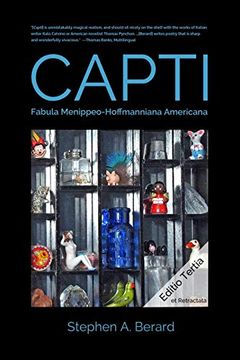Reseña del libro "Capti: Fabula Menippeo-Hoffmanniana Americana (Heptologia Sphingis) (en Latin)"
In "Capti: Fabula Menippeo-Hoffmanniana Americana" ("The Captured Ones: A Menippeo-Hoffmannesque American Tale"), Stephen Berard weaves a multicultural, particolored, sometimes surreal and often hilarious tapestry of satire, magic realism, myth, science, and poetry that causes the reader to pinch himself, asking if he can actually be reading something like this in Latin. The central character is a highly functional autistic Seattle ballet dancer, Woody Fava, who speaks in verse and who uses chromoptic therapy in the form of colored eyeglasses to help himself make sense of his world. In search of the Goddess, whom he is sure has recently moved into a condo somewhere in Seattle, Woody quits his ballet job, quickly impoverishes himself, and has a series of disturbing misadventures, until finally disappearing...only to reemerge in Los Angeles at the center of a bizarre murder mystery. But this is only part of the story since Woody's life is reflected and refracted into a thousand other tales - yes, hints of Scheherazade! - lived out in other times and other contexts. > Berard's Menippean Fable (volume 1 of a planned heptology) is based in a very loose and often ironic way on two tales by the German romantic author E.T.A. Hoffmann: "Prinzessin Brambilla" and "Das Fräulein von Scuderi". While it is not necessary for the reader of "Capti" to be familiar with these tales, there are a few jokes that will escape those who have not read the Hoffmann works. > Very generally, it can be said that the author mixes old with new. He superimposes thoroughly modern themes and thought patterns on ancient literary genres and styles. Berard's hexameters emulate Juvenal, Lucan, and Lucretius. In the prose portions of the first chapter he often uses long, involved, sometimes misshapen sentences of a somewhat Apuleian sort in order to reflect the characters' emotions, confusions, and a generally rather Fellini-esque sort of exuberance. The style, however, varies from passage to passage. The poetic verse forms evolve gradually from hexameters to medieval meters to modern blank verse...which in turn is meant to represent changes in, or the outright dissolution of, the world of the various protagonists as well as providing a pleasant lesson in modern poetics for those wanting one. > Although Berard has chosen an ancient literary form called the Menippean Fable, he has derived many of his compositional principles from Hoffmann himself, the inventor of fantastic realism and great-grandfather of the now popular magic realism. In magic realism--among whose principal exponents have been Gabriel Garcia Marquez, Miguel Angel Asturias, Jorge Luis Borges, Richard Brautigan, William Burroughs, Italo Calvino, Carlos Fuentes, and Virginia Woolf--a given story will normally seem realistic, although here and there, just under the surface of things, some kind of magic is at work. In Hoffmann's earlier fantastic realism, however, which Berard is cultivating in this book and will continue in the following ones, realism alternates with utmost fantasy, and it is the job of the reader to establish the connections between these two modes. > The "Sphinx Heptology" will carry with it the message of quantum holism. In telling his amusing stories, Berard is endeavoring to propagate that famous notion, repeatedly confirmed by physics experimentation, that each so-called "part" of the universe is simultaneously both the part and the whole, that everything in the cosmos is directly linked with everything else at the quantum level, and that things happening "here" are expressed one way or another in all "places", that indeed, due to the proven phenomenon of quantum non-locality, the idea of "separate places" is an illusion...or, when seen in their wholeness, they are parts of a virtual hologram whose information is contained in no space. Berard has found fantastic realism, of all literary styles, to be the most appropriate for conveying these ideas to his readers.

